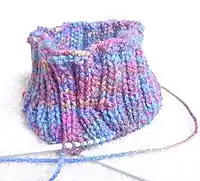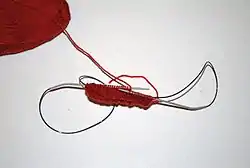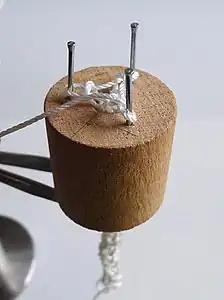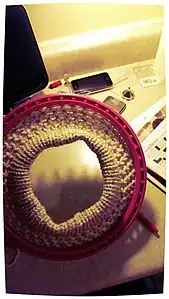Circular knitting
Circular knitting or knitting in the round is a form of knitting that creates a seamless tube. Work in the round is begun by casting on stitches as for flat knitting but then joining the ends of that row of stitches to form a circle. Knitting is worked in rounds (the equivalent of the rows in flat knitting), which forms the tube by winding around in a helix.[1]





Originally, circular knitting was done using a set of four or five double-pointed needles. Today, knitters often use instead a circular needle, which resembles a pair of short knitting needles connected by a cable between them. Circular knitting can also be performed by knitting machines: a double-bed machine can be set up to knit on its front bed in one direction and then its back bed on the return, which creates the tube.[2][3] Specialized knitting machines for sock-knitting use individual latch-hook needles to make each stitch in a round frame.[4]
Many types of sweaters are traditionally knit in the round. Planned openings (arm holes, necks, cardigan fronts) are temporarily knitted with extra stitches, reinforced if necessary. Then the extra stitches are cut to create the opening, and are stitched with a sewing machine to prevent unraveling.[5] This technique is called steeking.
Magic loop technique
Invented by Sarah Hauschka and first described in Beverly Galeskas’s booklet The Magic Loop, this technique uses a long circular knitting needle[6] (for instance 40 inches) to knit projects (of any circumference substantially less than the needle length) in the round. The key is pulling a loop of extra cable out between the stitches halfway through the round.[7]
The magic loop technique also allows knitting two-at-a-time projects like pairs of socks or the sleeves of sweaters. This knitting both pieces at once makes it easier to render the two as similar as possible.
Spool and machine circular knitting
Spool knitting is a form of circular knitting using pegs rather than needles, one peg per stitch. A variant automates the stitching action, thus producing a hand-crank circular knitting machine. Commercial knitting machines are heavy-duty powered versions of the hand-cranked ones; they may knit multiple threads at once, for speed.
 Minimal spool knitting frame
Minimal spool knitting frame Fingerless gloves being knitted on a 12-peg frame
Fingerless gloves being knitted on a 12-peg frame Knitting a tuque (hat) on a larger frame
Knitting a tuque (hat) on a larger frame Oblong frame for circular knitting
Oblong frame for circular knitting It is not necessary to use the full length of an oblong frame
It is not necessary to use the full length of an oblong frame.jpg.webp) Narrow hand-cranked spool knitting machine
Narrow hand-cranked spool knitting machine Larger hand-cranked circular knitting machine
Larger hand-cranked circular knitting machine 18-hundreds knitting machine, also hand-cranked
18-hundreds knitting machine, also hand-cranked A similar old sock-knitting machine in use
A similar old sock-knitting machine in use Close-up of a similar machine
Close-up of a similar machine 1959 power knitting machine
1959 power knitting machine.jpg.webp) Side view of 1959 machine
Side view of 1959 machine Machine for fine knitting
Machine for fine knitting A commercial machine knitting wool, 2000
A commercial machine knitting wool, 2000
Notes
- "Circular needles". knitty.com.
- "Flat knitting machine having four opposed needle beds - Patent # 4100766 - PatentGenius". Archived from the original on 2007-09-27. Retrieved 2007-09-03.
- "Circular knitting machine - Patent # 3969912 - PatentGenius". Archived from the original on 2017-01-01. Retrieved 2017-01-01.
- "Sock Machine Museum Sock Knitting Machine Information, Sales, Patterns and Museum". www.oldtymestockings.com.
- "KidsKnits - Steeks Introduction". Archived from the original on 2016-02-24. Retrieved 2007-09-03.
- "Circular knitting needle".
- Wessel, Emily (October 3, 2013). "Magic Loop Technique: How To Knit in the Round Using a Single Long Circular Needle". tin can knits.
Further reading
- Allen, Pam, Trisha Malcolm, Rich Tennant, and Cheryl Fall (2002). Knitting for Dummies. New York: Hungry Minds, Inc. ISBN 978-0-7645-5395-0
- Breiter, Barbara, and Gail Diven (2003). The Complete Idiot's Guide to Knitting and Crocheting Illustrated, 2nd Edition. New York: Alpha Books. ISBN 978-1-59257-089-8
- Galeskas, Bev (2002). The Magic Loop: Working Around on One Needle. Fiber Trends. (Sixth edition ISBN 978-1933398006)
- Hiatt, June Hemmons (1989). The Principles of Knitting: Methods and Techniques of Hand Knitting. New York: Simon & Schuster. ISBN 978-0-671-55233-6
- Rutt, Richard (2003). A History of Handknitting. Loveland, CO: Interweave Press. (Reprint edition ISBN 1-931499-37-3)
- Zimmermann, Elizabeth (1972). Knitting Without Tears. New York: Simon & Schuster. (Reprint edition ISBN 0-684-13505-1)
External links
- "Large and Small Diameter Circular Knitting videos" from KnittingHelp
- "How to knit with one circular" from WeebleKnits
- "How to knit with two circulars" from WeebleKnits
- "How to knit small circumferences using one long circular needle" from WeebleKnits
